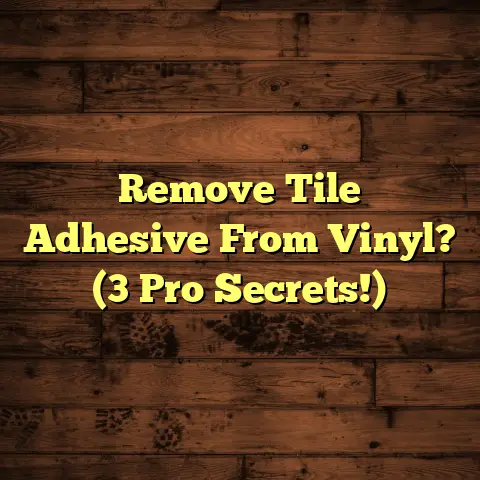Crumbling Garage Floor? Concrete Repair Guide (8 Steps!)
Think of your concrete floor like a layered cake. You’ve got your base (the subgrade), then your concrete mix itself, and maybe even a sealant on top. If one of those layers is weak or damaged, the whole thing starts to fall apart.
Just like a soggy cake bottom ruins the entire dessert, issues like moisture, poor installation, or harsh chemicals can wreak havoc on your concrete. So, how do we tackle this crumbling mess? Let’s dive into my step-by-step guide to restoring your garage floor to its former glory!
Section 1: Understanding the Problem
1. Identifying the Signs of Damage
Okay, let’s play detective. What are the telltale signs your garage floor is calling for help? Keep an eye out for these:
-
Cracks: Hairline cracks might seem harmless, but they’re like tiny highways for moisture to seep in. Larger cracks are even worse, indicating structural issues.
-
Flaking: This is when the surface of the concrete starts to peel or flake off. It’s often a sign of freeze-thaw damage or poor concrete quality.
-
Dusting: Notice a fine powder accumulating on the surface? That’s dusting, and it means your concrete is breaking down.
Ignoring these signs is like ignoring a leaky faucet – it only gets worse (and more expensive) over time. Cracks can widen, flaking can spread, and before you know it, you’re dealing with a major repair. Plus, a damaged floor can be a safety hazard, especially if you’re constantly tripping over loose chunks.
2. Causes of Crumbling Concrete
So, what’s causing all this mayhem? Here’s a breakdown of the usual suspects:
-
Moisture Infiltration: Water is concrete’s kryptonite. It seeps into pores and cracks, and when it freezes, it expands, putting immense pressure on the concrete.
-
Freeze-Thaw Cycles: Speaking of freezing, this is a big one, especially in colder climates. Repeated freezing and thawing cycles cause the concrete to crack and crumble.
-
Poor Installation Practices: Did the original installer cut corners? Using the wrong concrete mix, inadequate subgrade preparation, or improper curing can all lead to premature failure.
-
Chemical Exposure: Garage floors often face a barrage of chemicals, from road salt and oil spills to harsh cleaning products. These chemicals can corrode the concrete over time.
Understanding the “why” behind the damage is crucial. If you don’t address the underlying cause, your repairs will only be a temporary fix.
Section 2: Gather Your Tools and Materials
3. Preparation for Repair
Alright, time to gear up! Here’s what you’ll need to tackle this project:
-
Safety Gear: Safety glasses, gloves, and a dust mask are essential. Concrete dust is nasty stuff, and you don’t want it in your eyes or lungs.
-
Concrete Mix: Choose a concrete mix specifically designed for patching and repairing concrete floors. I personally like using a pre-mixed concrete patch. It saves time and ensures the right consistency.
-
Trowels: You’ll need a variety of trowels for applying and smoothing the concrete. A margin trowel is great for small areas, while a larger finishing trowel is ideal for larger surfaces.
-
Chisels and Hammer: For removing loose or crumbling concrete, a chisel and hammer are your best friends.
-
Wire Brush: A wire brush helps clean the repair area and remove any loose debris.
-
Concrete Bonding Adhesive: This helps the new concrete bond to the old concrete.
-
Concrete Sealer: After the repair is complete, seal the surface to protect it from future damage.
-
Mixing Bucket: For mixing the concrete, unless using a premix.
-
Water: For mixing the concrete.
-
Level: To check the surface is flat.
-
Measuring Tape: To mark out repair areas.
-
Broom or Shop Vac: For cleaning up the area.
You can find most of these items at your local hardware store or home improvement center. If you don’t want to buy everything, some tool rental places offer concrete tools for rent.
Section 3: Preparing the Garage Floor for Repair
4. Cleaning and Inspection
Before you start slinging concrete, you need to prep the area. Here’s how:
-
Clear the Area: Remove everything from the garage floor. You want a clean, unobstructed workspace.
-
Sweep and Vacuum: Sweep away any loose debris, dirt, and dust. Then, use a shop vac to get rid of any remaining particles.
-
Wash the Floor: Use a concrete cleaner and a scrub brush to thoroughly clean the floor. Rinse with clean water and let it dry completely.
-
Inspect for Underlying Issues: Once the floor is clean, take a close look for any signs of moisture or structural damage. Are there any cracks that extend deep into the concrete? Is the subgrade stable? If you find any serious issues, it’s best to consult a professional.
Section 4: Assessing the Severity of Damage
5. Determining the Extent of Repairs Needed
Now, let’s figure out how deep we need to go with these repairs.
-
Minor Damage: If you only have a few small cracks or patches of flaking, a simple patching job might be all you need.
-
Moderate Damage: Larger cracks, widespread flaking, or dusting require a more extensive repair. You might need to remove a larger area of concrete and apply a thicker layer of patching material.
-
Severe Damage: If the concrete is severely cracked, crumbling, or structurally unsound, it might be time to call in the pros. Replacing the entire garage floor might be the only option.
When to Call a Pro:
- Large Cracks: Cracks wider than 1/4 inch or that run deep into the concrete.
- Uneven Surfaces: Significant dips or unevenness in the floor.
- Structural Issues: If you suspect the subgrade is unstable or the foundation is compromised.
- You’re Overwhelmed: If you’re not comfortable tackling the repair yourself, don’t hesitate to call a professional.
Section 5: The Repair Process (Step-by-Step Guide)
Okay, time to get our hands dirty! Here’s my step-by-step guide to repairing your crumbling garage floor:
6. Step 1: Prepare the Repair Area
-
Mark the Area: Use a chisel and hammer to create a clean edge around the damaged area. This will help the new concrete bond to the old concrete.
-
Remove Loose Concrete: Use the chisel and hammer to remove any loose or crumbling concrete within the marked area.
-
Clean the Area: Use a wire brush to clean the repair area and remove any remaining debris.
7. Step 2: Mix the Concrete
-
Read the Instructions: Follow the manufacturer’s instructions for mixing the concrete.
-
Add Water: Add water gradually to the concrete mix, stirring constantly until you reach a thick, but workable consistency. It should be similar to a thick oatmeal.
-
Mix Thoroughly: Make sure the concrete is thoroughly mixed and there are no dry clumps.
8. Step 3: Apply the Concrete
-
Dampen the Area: Lightly dampen the repair area with water. This will help the concrete bond to the old concrete.
-
Apply Bonding Adhesive: Apply a thin layer of concrete bonding adhesive to the repair area.
-
Apply Concrete: Use a trowel to apply the concrete to the repair area. Start by filling in the edges and then work your way towards the center.
-
Layering: Apply the concrete in thin layers, compacting each layer as you go. This will help prevent air pockets and ensure a strong, durable repair.
9. Step 4: Smooth and Level the Surface
-
Trowel the Surface: Use a trowel to smooth and level the surface of the concrete.
-
Feather the Edges: Feather the edges of the repair area to blend them seamlessly with the surrounding concrete.
-
Check for Level: Use a level to ensure the surface is flat.
10. Step 5: Curing the Concrete
-
Keep it Moist: Concrete needs to stay moist to cure properly. Cover the repair area with plastic sheeting or wet burlap and keep it damp for at least 3-7 days.
-
Avoid Traffic: Keep foot and vehicle traffic off the repaired area for at least 7 days, or as recommended by the concrete manufacturer.
11. Step 6: Sealing the Repair
-
Choose a Sealant: Choose a concrete sealant specifically designed for garage floors.
-
Apply Sealant: Follow the manufacturer’s instructions for applying the sealant.
-
Multiple Coats: Apply multiple coats of sealant for maximum protection.
12. Step 7: Allowing for Drying Time
- Patience is Key: Allow the sealant to dry completely before using the garage floor. This could take several hours or even a full day, depending on the sealant you use.
13. Step 8: Maintenance Tips for Longevity
-
Regular Cleaning: Sweep and mop the garage floor regularly to remove dirt, dust, and debris.
-
Clean Spills Immediately: Clean up any spills immediately to prevent staining and damage.
-
Use a Concrete Sealer: Reapply concrete sealer every 1-2 years to protect the floor from moisture and chemicals.
-
Avoid Harsh Chemicals: Avoid using harsh chemicals or abrasive cleaners on the garage floor.
-
Inspect Regularly: Inspect the garage floor regularly for any signs of damage and repair them promptly.
Conclusion
So, there you have it! A step-by-step guide to tackling that crumbling garage floor. It might seem like a daunting task, but with the right tools, materials, and a little elbow grease, you can restore your garage floor and prevent further damage.
Remember, addressing a crumbling garage floor promptly isn’t just about aesthetics; it’s about safety and preventing bigger problems down the road. Take pride in your home improvement projects and enjoy the satisfaction of a well-maintained garage floor!
Call to Action
Have you tackled a garage floor repair project before? What tips and tricks did you learn along the way? Share your experiences and questions in the comments below! And don’t forget to check out my other guides and resources for more home improvement tips and tricks. Let’s get those garages looking their best!





